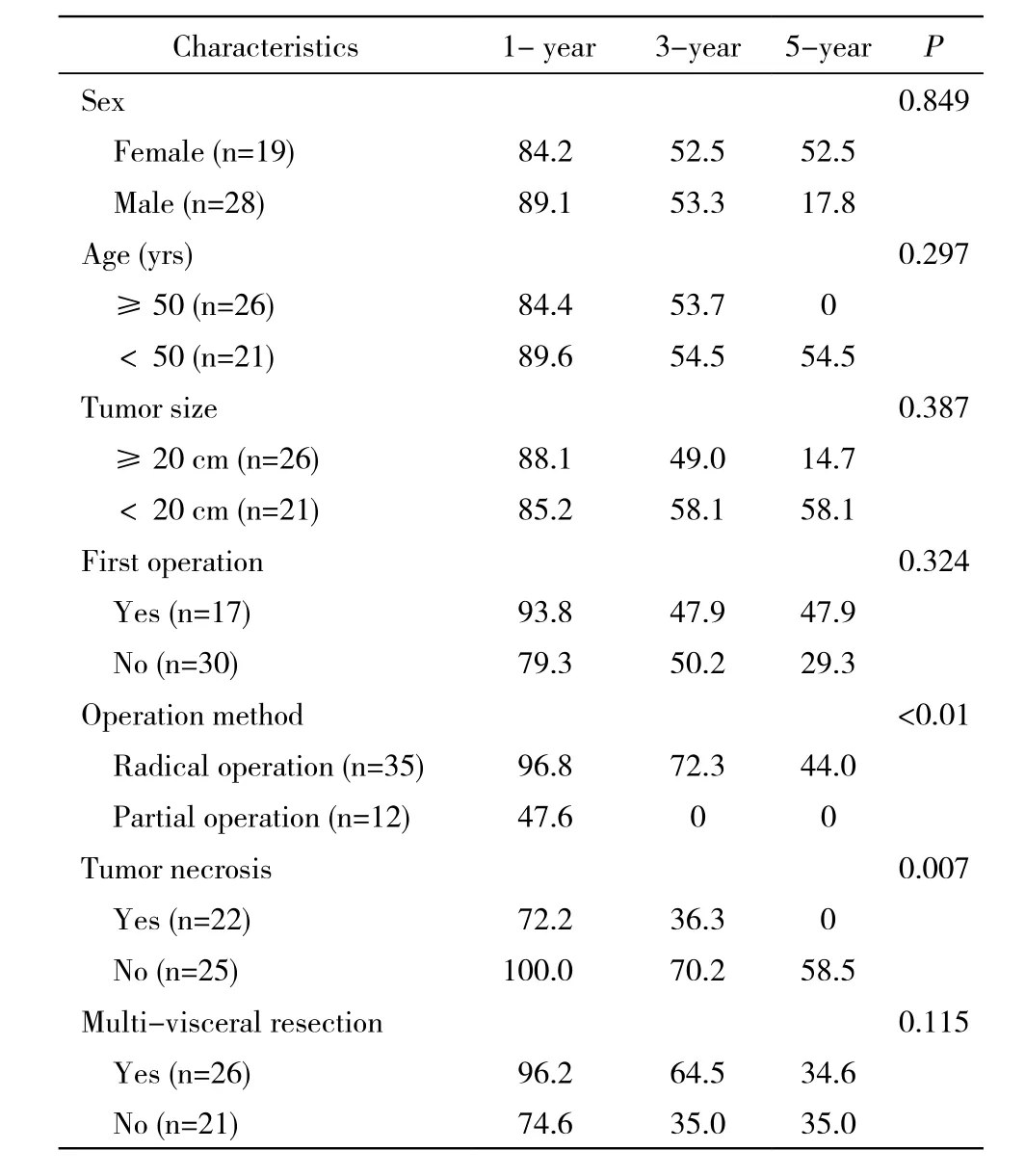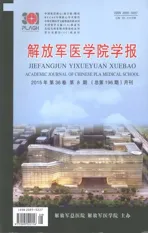腹膜后多形型脂肪肉瘤的外科治疗及预后影响因素分析
2015-03-21孙成博李沛雨卢灿荣黄晓辉
孙成博,李沛雨,卢灿荣,黄晓辉,张 楠,刘 娜
解放军总医院 普通外科,北京 100853
腹膜后多形型脂肪肉瘤的外科治疗及预后影响因素分析
孙成博,李沛雨,卢灿荣,黄晓辉,张 楠,刘 娜
解放军总医院 普通外科,北京 100853
目的探讨腹膜后多形型脂肪肉瘤(retroperitoneal pleomorphic liposarcoma,RPL)的手术治疗及预后的影响因素。方法回顾性分析2007年6月- 2013年12月我院收治的47例腹膜后多形型脂肪肉瘤患者的临床资料,并对其预后进行随访。结果全部患者中17例为首次手术,30例为再次手术;35例接受了根治性手术切除,12例部分切除。中位生存时间20(2 ~64)个月,1年、3年、5年总体生存率分别为86.9%、52.5%和32.0%。Log-rank检验显示,手术根治程度(χ2=43.038,P<0.01)和肿瘤是否伴有坏死(χ2=7.280,P=0.007)与患者术后生存时间相关;而性别、年龄、肿瘤大小、是否联合脏器切除、是否初次手术对患者的预后生存无影响。多因素分析显示,手术根治程度(RR=61.630,P<0.01)和肿瘤是否伴有坏死(RR=0.216,P=0.019)是腹膜后多形型脂肪肉瘤预后的独立影响因素。结论腹膜后多形型脂肪肉瘤预后较差,手术根治性切除是目前主要的治疗方法。为达到根治切除的目的,常需要联合周围脏器切除。根治性切除、肿瘤无坏死患者的预后较好。
多形型脂肪肉瘤;腹膜后肿瘤;手术治疗;预后
多形型脂肪肉瘤(retroperitoneal pleomorphic liposarcoma,RPL)是脂肪肉瘤中少见的类型,病灶位于腹膜后腔者更少(约7%)。多形型脂肪肉瘤的典型特点是高度异型和数量不等的泡沫细胞,可凭借此特点与其他类型的脂肪肉瘤相鉴别[1]。腹膜后多形型脂肪肉瘤是一种高级别肿瘤,预后相对不佳[2]。由于临床上发病较少,目前对其研究很少。本研究主要分析腹膜后多形型脂肪肉瘤的临床特点,手术治疗以及影响术后生存时间的因素。
资料和方法
1 一般资料 收集2007年6月- 2013年12月我院收治的47例腹膜后多形型脂肪肉瘤患者的临床资料。纳入标准:1)患者经影像学检查(CT、MRI)明确肿瘤部位;2)全部病理切片经本院病理科医师复诊,以法国联邦癌症中心标准对肿瘤级别和分化程度等进行评价;3)有完整的临床病理资料。排除标准:1)未接受手术者;2)围术期死亡者;3)失访者。最终47例患者纳入研究。
2 随访 采用门诊随诊和术后定期电话随访,随访截至日期为2014年12月,中位随访时间20(2 ~64)个月。对患者术后生存时间可能有影响的因素包括性别、年龄、手术根治程度、是否为初次手术、肿瘤是否伴有坏死、是否联合脏器切除。患者术后生存时间以在我院初次手术日为起点,死亡或2014年12月的末次回访时间(未发生终点事件的患者)作为终点或截点(截尾数据),计算患者的术后生存时间。
3 统计学方法 采用SPSS19.0统计软件进行统计分析,计数资料用率(%)表示。单因素生存分析采用Kaplan-Meier法计算,Log-rank检验;多因素生存分析采用Cox风险比例模型。P<0.05为差异有统计学意义。
结 果
1 主要临床特点 本组47例中,男性28例,女性19例;平均年龄51(26 ~75)岁;其中≥50岁26例,<50岁21例;临床表现主要为腹部肿块39例,腹痛、腹胀17例,腰背痛9例,便秘4例,肾积水2例。
2 手术情况 初次手术者17例,再次手术者30例;26例接受了联合脏器切除,根治手术者35例,部分切除手术者12例;肿瘤最大径≥20 cm者26例,<20 cm 21例;肿瘤伴有坏死22例,肿瘤无坏死25例。术中联合脏器切除者26例,切除的脏器包括结肠(13例)、小肠(7例)、右肾(6例)、左肾(4例)、脾(3例)、输尿管(1例)、髂血管(1例)、胰腺(1例)、输卵管(1例)。其中11例为联合多器官切除。3 预后及影响因素 随访至2014年12月,47例中死亡20例,死因均为肿瘤复发。中位生存时间为20(2 ~ 64)个月。1年、3年、5年生存率分别为86.9%、52.5%和32.0%。Log-rank检验发现,手术是否为根治性切除(χ2=43.038,P<0.01)以及肿瘤坏死(χ2=7.280,P=0.007)是影响患者生存时间的主要因素(图1)。本组根治性切除者1年、3年、5年生存率分别为96.8%、72.3%、44.0%。肿瘤有坏死者1年、3年、5年生存率分别为72.2%、36.3%、0;无坏死者1年、3年、5年生存率分别为100%、70.2%、58.5%(表1)。多因素分析显示,是否手术根治切除(RR=61.630,P<0.01)和肿瘤是否伴有坏死(RR=0.216,P=0.019)是预后的独立影响因素(表2)。
讨 论
脂肪肉瘤是成人最常见的软组织肉瘤,约占软组织肉瘤中的20%[3-4]。世界卫生组织(WTO)将其分为4种类型:高分化型、去分化型、黏液型/圆细胞型和多形型[2]。多形型脂肪肉瘤是最少见的类型[1,5],相关研究报道也很少。根据法国联邦癌症中心标准,多形型脂肪肉瘤是属于高级别软组织肉瘤(3级)[6],而高级别肉瘤预示预后不佳。本组47例患者纳入研究,男女发病无明显差异,平均发病年龄51(26 ~ 75)岁。
腹膜后多形型脂肪肉瘤和其他类型脂肪肉瘤一样,发病隐匿,发现时肿瘤多已较大[7]。本组病例常见临床症状有腹部肿块、腹痛腹胀、腰背痛等。肿瘤最大径平均20 cm,与以往报道基本一致[7]。本组病例未发现肿瘤大小影响术后生存时间。

图 1 Kaplan-Meier生存曲线分析手术根治切除和肿瘤是否伴有坏死与生存时间的关系(n=47)。Y轴代表患者的百分比;X轴表示生存时间Fig. 1 Kaplan Meier survival curves for overall survival stratified according to radical resection and tumor necrosis. Y represents the survival rate of patients (%); X represents the survival time (month)

表1 腹膜后多形型脂肪肉瘤患者的1年、3年、5年生存率Tab. 1 1-, 3-, 5-year survival rate of RPL patients (n, %)

表2 Cox多因素分析腹膜后多形型脂肪肉瘤患者术后预后影响因素Tab. 2 Multivariate analysis showing the independent factors on the survival prognosis of patients with retroperitoneal pleomorphic liposarcoma
肿瘤坏死是由于实体肿瘤生长过快,以致慢性缺血损伤造成,可反映瘤体内部缺氧的程度[8]。很多常见肿瘤预后和肿瘤坏死有明显的相关性,肿瘤坏死程度越高,预后越差[9-13]。本组有22例肿瘤伴有不同程度的坏死,通过Kaplan-Meier法生存分析,其预后明显较无肿瘤坏死者差(P<0.05)。伴有肿瘤坏死者1年、3年、5年生存率分别为72.2%、36.3%、0,无肿瘤坏死者1年、3年、5年生存率分别为100%、70.2%、58.5%。可见肿瘤坏死可作为腹膜后多形型脂肪肉瘤的预后评价指标。
目前手术根治性切除是公认的治疗脂肪肉瘤的有效办法[2,5]。本组35例接受了根治性手术切除。通过生存分析,我们发现手术根治性切除患者预后明显好于部分切除者(P<0.01)。有报道指出,部分切除肿瘤虽不能达到根治患者病症的目的,但可有效缓解肿瘤的压迫症状,延长生存时间[2,14-16]。因此,我们认为应针对该病的特点应力求做到根治切除,无法切除者,应力求减瘤。为达到根治切除的目的,常需要联合周围脏器切除,有研究发现,肾是最常被合并切除的器官,其次是结肠[5]。本组联合切除最常见为结肠(13例次),其次为小肠和肾,其中肾又以右肾较为多见。本组病例未发现联合脏器切除者和无联合脏器切除者预后有差异,与以往报道一致[7]。我们认为,为达到根治目的,可根据术中情况联合周围器官切除。
多因素分析显示,手术根治度和肿瘤坏死程度是腹膜后多形型脂肪肉瘤预后的独立影响因素。虽然有报道认为黏液型脂肪肉瘤对放疗比较敏感[17],但绝大多数研究认为放化疗对于腹膜后脂肪肉瘤的治疗作用有限[1-2,5]。
总之,腹膜后多形型脂肪肉瘤是一种少见的肿瘤类型,属于高级别肿瘤,预后较高分化脂肪肉瘤差。手术根治性切除是有效的治疗方法。手术根治切除和肿瘤是否伴有坏死是判断预后的独立因素。
1 Hornick JL, Bosenberg MW, Mentzel T, et al. Pleomorphic liposarcoma - Clinicopathologic analysis of 57 cases[J]. Am J Surg Pathol, 2004, 28(10): 1257-1267.
2 Fletcher CDM, Unni KK, Mertens F. WHO classification of tumors pathology and genetics of tumours of soft tissue and bone[M]. Lyon: IARC Press, 2002: 427.
3 Fernández-Ruiz M, Rodríguez-Gil Y, Guerra-Vales JM, et al. Primary retroperitoneal liposarcoma: clinical and histological analysis of ten cases[J]. Gastroenterol Hepatol, 2010, 33(5):370-376.
4 Lewis JJ, Leung D, Woodruff JM, et al. Retroperitoneal soft-tissue sarcoma - Analysis of 500 patients treated and followed at a single institution[J]. Ann Surg, 1998, 228(3): 355-363.
5 Lee SY, Goh BK, Teo MC, et al. Retroperitoneal liposarcomas:the experience of a tertiary Asian center[J]. World J Surg Oncol,2011, 9:12.
6 Reiffers J. The French comprehensive cancer centers in the French oncology landscape[J]. Bull Cancer, 2013, 100(6): 611-617.
7 Singer S, Antonescu CR, Riedel E, et al. Histologic subtype and margin of resection predict pattern of recurrence and survival for retroperitoneal liposarcoma[J]. Ann Surg, 2003, 238(3):358-370.
8 Langner C, Hutterer G, Chromecki T, et al. Tumor necrosis as prognostic indicator in transitional cell carcinoma of the upper urinary tract[J]. J Urol, 2006, 176(3):910-913.
9 Richards CH, Roxburgh CS, Anderson JH, et al. Prognostic value of tumour necrosis and host inflammatory responses in colorectal cancer[J]. Br J Surg, 2012, 99(2):287-294.
10 Pollheimer MJ, Kornprat P, Lindtner RA, et al. Tumor necrosis is a new promising prognostic factor in colorectal cancer[J]. Hum Pathol, 2010, 41(12): 1749-1757.
11 Schneider NI, Langner C. Prognostic stratification of colorectal cancer patients: current perspectives[J]. Cancer Manag Res, 2014, 6:291-300.
12 Saha S, Shaik M, Johnston G, et al. Tumor size predicts long-term survival in colon cancer: an analysis of the National Cancer Data Base[J/OL]. http://linkinghub.elsevier.com/retrieve/pii/S0002-9610(14)00651-5.
13 Pichler M, Hutterer GC, Chromecki TF, et al. Histologic tumor necrosis is an Independent prognostic indicator for clear cell and papillary renal cell carcinoma[J]. Am J Clin Pathol, 2012, 137(2):283-289.
14 Shibata D, Lewis JJ, Leung DH, et al. Is there a role for incomplete resection in the management of retroperitoneal liposarcomas?[J]. J Am Coll Surg, 2001, 193(4):373-379.
15 Dodd LG, Sara Jiang X, Rao K, et al. Pleomorphic liposarcoma: A cytologic study of five cases[J]. Diagn Cytopathol, 2015, 43(2):138-143.
16 Keung EZ, Hornick JL, Bertagnolli MM, et al. Predictors of outcomes in patients with primary retroperitoneal dedifferentiated liposarcoma undergoing surgery[J]. J Am Coll Surg, 2014, 218(2): 206-217.
17 Haniball J, Sumathi VP, Kindblom LG, et al. Prognostic factors and metastatic patterns in primary myxoid/round-cell liposarcoma[J/ OL]. http://www.hindawi.com/journals/sarcoma/2011/538085.
Surgical therapy and prognostic factors analysis of retroperitoneal pleomorphic liposarcoma
SUN Chengbo, LI Peiyu, LU Canrong, HUANG Xiaohui, ZHANG Nan, LIU Na
Department of General Surgery, Chinese PLA General Hospital, Beijing 100853, China
LI Peiyu. Email: lipeiyu6301@163.com
ObjectiveTo evaluate the treatment outcome and identify prognostic factors for patients with retroperitoneal pleomorphic liposarcoma.MethodsClinical data about 47 patients with retroperitoneal pleomorphic liposarcoma managed with surgery from June 2007 to December 2013 in our hospital were retrospectively analyzed and all patients were followed up.ResultsOf the 47 cases, 17 patients received surgical resection for the first time, 30 patients were recurrent, 35 patients received radical resection, 12 cases received partial resection. The overall 1-, 3-, 5-year survival were 86.9%, 52.5% and 32.0% and the median survival time was 20 (2- 64) months. Log Rank test showed that radical surgery (χ2=43.038, P<0.01) and tumor necrosis (χ2=7.280, P=0.007) were associated with postoperative survival time. The difference between gender, age, removal of the joint organs, tumor size, primary or recurrent showed no statistical significance. Multivariate analysis showed that radical surgery (RR=61.630, P<0.01) and tumor necrosis (RR=0.216, P=0.019) were prognostic indicators for retroperitoneal pleomorphic liposarcoma.ConclusionRetroperitoneal pleomorphic liposarcoma is the rarest type. It belongs to the high grade of tumor, and its prognosis is poor. Complete resection remains the mainstream treatment for retroperitoneal pleomorphic liposarcoma. In order to reach the goal of radical resection, resections of other adjacent organs are often needed. Radical resection and no tumor necrosis predict better postoperative survival period.
pleomorphic liposarcoma; retroperitoneal neoplasms; surgery; prognosis
R 735.4
A
2095-5227(2015)06-0553-04
10.3969/j.issn.2095-5227.2015.06.008
时间:2015-03-16 11:19
http://www.cnki.net/kcms/detail/11.3275.R.20150316.1119.002.html
2015-01-15
孙成博,男,在读硕士。Email: thankers@126.com
李沛雨,男,主任医师,主任,硕士生导师。Email: lip eiyu6301@163.com
